The Effect of Climate Change on the Hydropower Potential in the Kunhar River Watershed, Pakistan
Abstract
1. Introduction
- -
- To evaluate the impacts of climate change on the streamflow in the Kunhar River basin;
- -
- To determine how climate change would influence the hydropower potential.
2. Materials and Methods
2.1. Data Acquisition
2.2. Methodology
2.2.1. Climate Change Assessment
2.2.2. Hydrological Modeling
2.2.3. Projected Streamflow Assessment
2.2.4. Hydropower Analysis
2.2.5. Ungauged Sites Streamflow
2.3. Study Area
3. Results
3.1. Climatic Projections
3.2. Sensitivity, Calibration, and Validation of a Hydrological Model
3.2.1. Sensitivity Analysis
3.2.2. Calibration and Validation
3.3. Impact of Climate Change on Runoff
3.4. Estimation of Change in Hydropower Potential
4. Discussion
Policy Implications
5. Conclusions
- The maximum and minimum temperatures are predicted to rise by 2.0 °C and 3.0 °C under the SSP 2–45 and by 3.7 °C and 4.4 °C under the SSP 5–85 scenario in the 2080s.
- Based on these combined outcomes of three GCMs, precipitation may increase nearly 10 to 8% under the SSP 2–45 and 5–85 scenarios, respectively, in the 2080s.
- The average annual streamflow may increase by 15 and 11% under the SSP 2–45 and 5–85 scenarios, respectively, in the 2080s.
- The high flow and median flow may increase by 14 and 15%, respectively, and the low flow may decline by 30% under SSP 5–85 in the 2080s.
- Moreover, climate change can alter the hydropower potential significantly, from 24 and 16% under SSP 2–45 and SSP 5–85, respectively, in the 2080s.
- Hydropower operators might need to adjust their reservoir management strategies to optimize energy production while accounting for changing inflow patterns.
- In most cases, a large uncertainty is associated with the climate change projections, which is a limitation of this study.
- It is recommended to employ several regional climate models instead of relying solely on GCMs, apply various bias correction techniques, and incorporate future land use data when simulating the hydrological model to minimize uncertainty.
Supplementary Materials
Author Contributions
Funding
Institutional Review Board Statement
Informed Consent Statement
Data Availability Statement
Acknowledgments
Conflicts of Interest
References
- Steffen, W.; Crutzen, P.J.; McNeill, J.R. The Anthropocene: Are humans now overwhelming the great forces of nature. Ambio 2007, 36, 614–621. [Google Scholar] [CrossRef] [PubMed]
- Intergovernmental Panel on Climate Change (IPCC). Climate Change Fifth Assessment Report. 2014. Available online: https://ar5-syr.ipcc.ch/topic_summary.php (accessed on 15 June 2021).
- Kattumuri, R. Sustaining natural resources in a changing environment: Evidence. policy and impact. Contemp. Soc. Sci. 2018, 13, 1–16. [Google Scholar] [CrossRef]
- Hamududu, B.; Aanund, K. Assessing Climate Change Impacts on Global Hydropower. Energy 2012, 5, 305–322. [Google Scholar]
- Savelsberg, J.; Moritz, S.; Ingmar, S.; Hannes, W. The Impact of Climate Change on Swiss Hydropower. Sustainability 2018, 10, 2541. [Google Scholar] [CrossRef]
- Babur, M.; Babel, M.S.; Shrestha, S.; Kawasaki, A.; Tripathi, N.K. Assessment of Climate Change Impact on Reservoir Inflows Using Multi Climate-Models under RCPs—The Case of Mangla Dam in Pakistan. Water 2016, 8, 389. [Google Scholar] [CrossRef]
- Intergovernmental Panel on Climate Change (IPCC). Climate Change Sixth Assessment Report. 2021. Available online: https://www.ipcc.ch/report/ar6/wg1/downloads/report/IPCC_AR6_WGI_SPM_final.pdf (accessed on 15 June 2021).
- Al-Mukhtar, M.; Dunger, V.; Merkel, B. Assessing the impacts of climate change on hydrology of the upper reach of the Spree river: Germany. Water. Resour. Manag. 2014, 28, 2731–2749. [Google Scholar] [CrossRef]
- Abbasa, N.; Wasimia, S.A.; Al-Ansari, N. Assessment of Climate Change Impact on Water Resources of Lesser Zab, Kurdistan, Iraq Using SWAT Model. Engineering 2016, 8, 697–715. [Google Scholar] [CrossRef][Green Version]
- Mahmood, R.; Shaofeng, J. Assessment of Impacts of Climate Change on the Water Resources of the Transboundary Jhelum River Basin of Pakistan and India. Water 2016, 8, 246. [Google Scholar] [CrossRef]
- Tehrani, M.J.; Haddad, O.B.; Loáiciga, H.A. Hydropower Reservoir Management Under Climate Change: The Karoon Reservoir System. Water. Resour. Manag. 2014, 29, 749–770. [Google Scholar] [CrossRef]
- Liu, X.; Qiuhong, T.; Nathalie, V.; Huijuan, C. Projected impacts of climate change on hydropower potential in China. Hydrol. Earth. Syst. Sci. 2016, 20, 3343–3359. [Google Scholar] [CrossRef]
- Akbar, H.; Gheewala, S.H. Effect of climate change on cash crops yield in Pakistan. Arab. J. Geosci. 2020, 13, 390. [Google Scholar] [CrossRef]
- Pervez, M.S.; Geoffrey, M.H. Assessing the Impacts of Climate and Land Use and Land Cover Change on The Freshwater Availability in The Brahmaputra River Basin. J. Hydrol. Reg. Stud. 2015, 3, 285–311. [Google Scholar] [CrossRef]
- Woldesenbet, T.A.; Nadir, A.E.; Lars, R.; Jürgen, H. Catchment Response to Climate and Land Use Changes in The Upper Blue Nile Sub-Basins, Ethiopia. Sci. Total. Environ. 2018, 644, 193–206. [Google Scholar] [CrossRef]
- Strasser, U.; Kristian, F.; Herbert, F.; Florentin, H.; Thomas, M.; Gertraud, M.; Imran, N.; Rike, S.; Markus, S. Storylines of Combined Future Land Use and Climate Scenarios and Their Hydrological Impacts in an Alpine Catchment (Brixental/Austria). Sci. Total Environ. 2019, 657, 746–763. [Google Scholar] [CrossRef] [PubMed]
- Kepa, S.; Emilio, C. The Impact of Climate Change on the Generation of Hydroelectric Power—A Case Study in Southern Spain. Energies 2017, 10, 1343. [Google Scholar]
- Fecher, R.S.; Arthur, C.; Francis, Y.; Hartley, W.; Harald, L.; Bernard, T.; Imasiku, N.; Boaventura, C. The Vulnerability of Hydropower Production in The Zambezi River Basin to The Impacts of Climate Change and Irrigation Development. Mitig. Mitig Adapt. Strateg. 2014, 19, 721–742. [Google Scholar]
- Abera, F.F.; Asfaw, D.H.; Engida, A.N.; Melesse, A.M. Optimal Operation of Hydropower Reservoirs Under Climate Change: The Case of Tekeze Reservoir, Eastern Nile. Water 2018, 10, 273. [Google Scholar] [CrossRef]
- Chiang, J.L.; Han, C.Y.; Yie, R.C.; Ming, H.L. Potential Impact of Climate Change on Hydropower Generation in Southern Taiwan. Energy Procedia 2013, 40, 34–37. [Google Scholar] [CrossRef]
- OCHA. Global Climate Risk Index. 2023. Available online: https://reliefweb.int/report/pakistan/climate-crisis-pakistan-voices-ground#:~:text=According%20to%20the%20Global%20Climate,the%20years%201999%20to%202018 (accessed on 5 November 2023).
- Saifullah, M.; Adnan, M.; Zaman, M.; Wałęga, A.; Liu, S.; Khan, M.I.; Gagnon, A.S.; Muhammad, S. Hydrological Response of the Kunhar River Basin in Pakistan to Climate Change and Anthropogenic Impacts on Runoff Characteristics. Water 2021, 13, 3163. [Google Scholar] [CrossRef]
- Akbar, H.; Gheewala, S.H. Changes in the hydroclimatic trends in the Kunhar river watershed. JSEE 2020, 11, 31–41. [Google Scholar]
- Akbar, H.; Gheewala, S.H. Impact of Climate and Land Use Changes on flowrate in the Kunhar River Basin, Pakistan, for the Period (1992–2014). Arab. J. Geosci. 2021, 14, 707. [Google Scholar] [CrossRef]
- Soomro, S.; Hu, C.; Jian, S.; Wu, Q.; Boota, M.W.; Soomro, M.H.A.A. Precipitation changes and their relationships with vegetation responses during 1982–2015 in Kunhar River basin, Pakistan. Water. Supp. 2021, 21, 3657–3671. [Google Scholar] [CrossRef]
- Soomro, S.; Hu, C.; Boota, M.W.; Wu, Q.; Soomro, M.H.A.A.; Zhang, L. Assessment of the Climatic Variability of the Kunhar River Basin, Pakistan. Water 2021, 13, 1740. [Google Scholar] [CrossRef]
- Mahmood, R.; Jia, S.; Babel, M.S. Potential Impacts of Climate Change on Water Resources in the Kunhar River Basin, Pakistan. Water 2016, 8, 23. [Google Scholar] [CrossRef]
- Edwards, P.N. History of Climate Modeling. Clim. Chang. 2011, 2, 128–139. [Google Scholar] [CrossRef]
- Sanderson, B.; Knutti, R. Climate Change Projections: Characterizing Uncertainty Using Climate Models. In Encyclopedia of Sustainability Science and Technology; Meyers, R.A., Ed.; Springer: New York, NY, USA, 2012. [Google Scholar] [CrossRef]
- Kim, K.B.; Kwon, H.H.; Han, D. Bias correction methods for regional climate model simulations considering the distributional parametric uncertainty underlying the observations. J. Hydrol. 2015, 530, 568–579. [Google Scholar] [CrossRef]
- Parker, W.S. Ensemble modeling, uncertainty and robust predictions. WIREs Clim. Chang. 2013, 4, 213–223. [Google Scholar] [CrossRef]
- Falloon, P.; Challinor, A.; Dessai, S.; Hoang, L.; Johnson, J.; Koehler, A.K. Ensembles and uncertainty in climate change impacts. Front. Environ. Sci. 2014, 2, 33. [Google Scholar] [CrossRef]
- Giorgi, F. Thirty years of regional climate modeling: Where are we and where are we going next? J. Geophys. Res. Atmos. 2019, 124, 5696–5723. [Google Scholar] [CrossRef]
- Guo, D.; Wang, H. Comparison of a very-fine-resolution GCM with RCM dynamical downscaling in simulating climate in China. Adv. Atmos. Sci. 2016, 33, 559–570. [Google Scholar] [CrossRef]
- Lutz, A.F.; Droogers, P.; Immerzeel, W. Climate Change Impact and Adaptation on the Water Resources in the Amu Darya and Syr Darya River Basins; Report FutureWater: 110; FutureWater: Wageningen, The Netherlands, 2012. [Google Scholar]
- Carbon Brief. Explainer: How ‘Shared Socioeconomic Pathways’ Explore Future Climate Change. 2023. Available online: https://www.carbonbrief.org/explainer-how-shared-socioeconomic-pathways-explore-future-climate-change/ (accessed on 5 November 2023).
- Suzuki-Parker, A.; Kusaka, H.; Takayabu, I.; Dairaku, K.; Ishizaki, N.N.; Ham, S. Contributions of GCM/RCM uncertainty in ensemble dynamical downscaling for precipitation in East Asian summer monsoon season. SOLA 2018, 14, 97–104. [Google Scholar] [CrossRef]
- Aslam, R.A.; Shrestha, S.; Pal, I.; Ninsawat, S.; Shanmugam, M.S.; Anwar, S. Projections of Climatic Extremes in a Data Poor Transboundary River Basin of India and Pakistan. Int. J. Climatol. 2020, 40, 4992–5010. [Google Scholar] [CrossRef]
- Neitsch, S.L.; Arnold, J.G.; Kiniry, J.R.; Williams, J.R. Soil and Water Assessment Tool Theoretical Documentation. 2005. Available online: https://swat.tamu.edu/media/1292/SWAT2005theory.pdf (accessed on 15 June 2021).
- Butts, M.B.; Payne, J.T.; Kristensen, M.; Madsen, H. An evaluation of the impact of model structure on hydrological modelling uncertainty for streamflow simulation. J. Hydrol. 2004, 298, 242–266. [Google Scholar] [CrossRef]
- The World Bank. Environment and Natural Resources Global Practice South Asia Region, Forests for Green Pakistan: Forest Policy Note. 2018. Available online: https://openknowledge.worldbank.org/entities/publication/7bd5e4a4-173c-562f-a396-9323f5bae78b (accessed on 17 March 2021).
- Searcy, J.K. Flow-Duration Curves. In Water Supply Paper 1542-A; United States Government Printing Office: Washington, DC, USA, 1959. [Google Scholar] [CrossRef]
- Khare, D.; Patra, D.; Mondal, A.; Kundu, S. Impact of Land Use/Land Cover Change on Run-Off in The Catchment of a Hydropower Project. Appl. Water. Sci. 2017, 7, 787–800. [Google Scholar] [CrossRef]
- Zaidi, A.Z.; Khan, M. Identifying high potential locations for run-of-the-river hydroelectric power plants using GIS and digital elevation models. Renew. Sust. Energ. Rev. 2018, 89, 106–116. [Google Scholar] [CrossRef]
- PHYDO. 300 MW Balakot Hydropower Project Feasibility Study Report Executive Summary. 2013. Available online: http://pedo.pk/uploads/downloads/es_balakot1.pdf (accessed on 22 March 2021).
- PHYDO. Investment Opportunities Hydropower Projects of Khyber Pakhtunkhwa. 2014. Available online: http://www.kpkep.gov.pk/documents/Brochure%202014.pdf (accessed on 11 March 2021).
- ADB. Asian Development Bank: Environmental Impact Assessment, Patrind Hydropower Project. 2010. Available online: https://www.1927.org/sites/default/files/project-documents//44914-014-pak-eia-a.pdf (accessed on 7 November 2023).
- Moiz, A.; Kawasaki, A.; Koike, T.; Shrestha, M. A systematic decision support tool for robust hydropower site selection in poorly gauged basins. Appl. Energy 2018, 224, 309–321. [Google Scholar] [CrossRef]
- Khan, M.; Zaidi, A.Z. Run-of-River Hydropower Potential of Kunhar River, Pakistan. Pak. J. Meteorol. 2015, 12, 25–32. [Google Scholar]
- Wang, R.S. Ordinary Differential Equation (ODE), Model. In Encyclopedia of Systems Biology; Dubitzky, W., Wolkenhauer, O., Cho, K.H., Yokota, H., Eds.; Springer: New York, NY, USA, 2013. [Google Scholar] [CrossRef]
- UNFCCC. Clean Development Mechanism Project Design Document Form (CDM-PDD) Version 03. 2006. Available online: https://cdm.unfccc.int/filestorage/A/6/V/A6VL3B7IJU2N91CP8Y54HQZGWOXFT0/Patrind%20Hydropower%20Project.pdf?t=bkl8cjZ5Z2xufDD5K4WjERAsxF7P9x4Uhj2h (accessed on 15 March 2021).
- Yin, C.; Zhao, W.; Pereira, P. Soil conservation service underpins sustainable development goals. Glob. Ecol. Conserv. 2022, 33, e01974. [Google Scholar] [CrossRef]
- Helston, C.; Farris, A. Run of River Power. 2017. Available online: http://www.energybc.ca/runofriver.html (accessed on 25 March 2021).
- Afework, B.; Cey, E.; Goodfellow, L.; Hanania, J.; Stenhouse, K.; Donev, J. Energy Education—Run-of-the-River Hydroelectricity. 2018. Available online: https://energyeducation.ca/encyclopedia/Run-of-the-river_hydroelectricity (accessed on 24 May 2022).
- Shu, J.; Qu, J.J.; Motha, R.; Xu, J.C.; Dong, D.F. Impacts of climate change on hydropower development and sustainability: A review. IOP Conf. Ser. Environ. Earth. Sci. 2018, 163, 012126. [Google Scholar] [CrossRef]

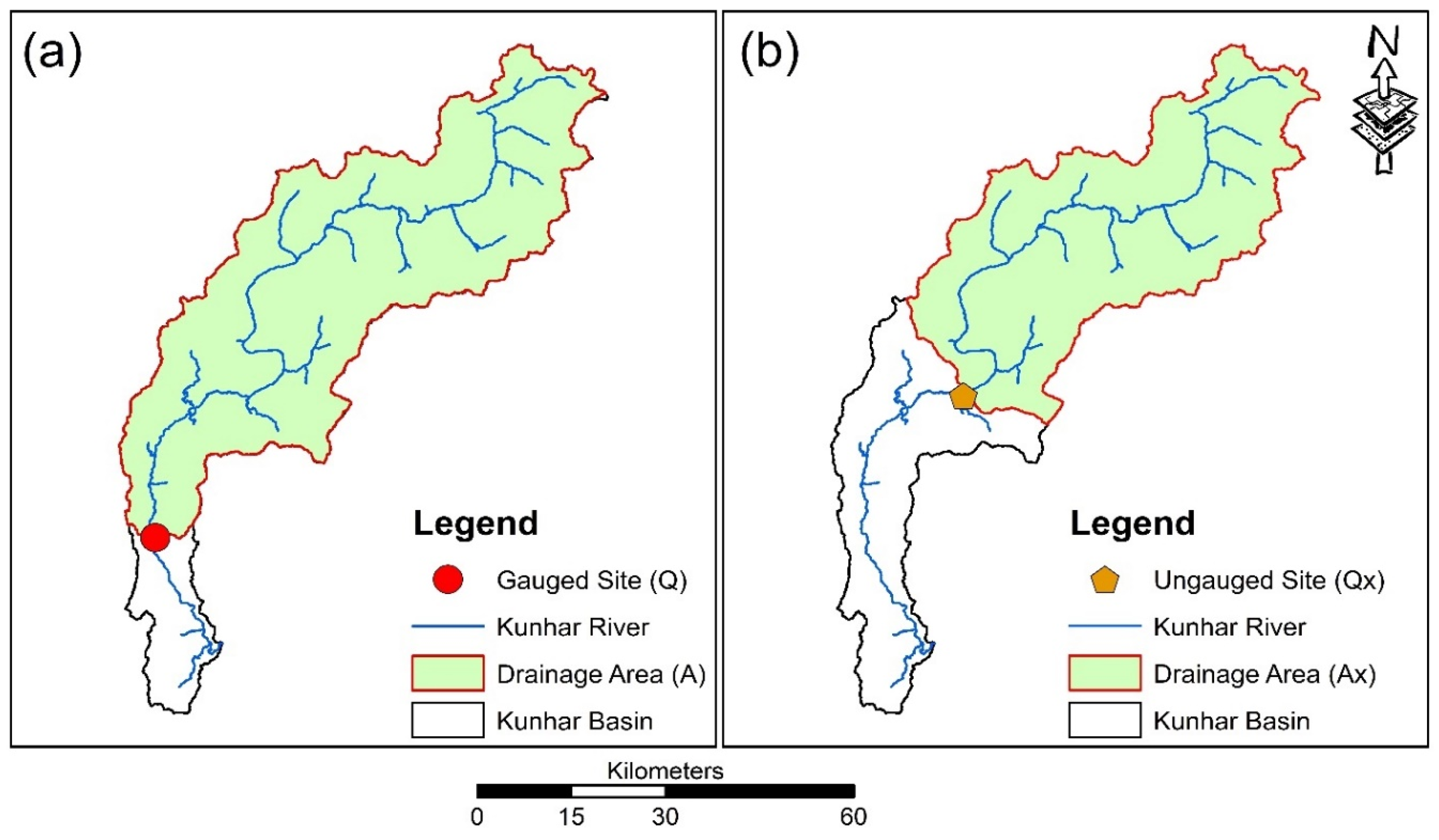
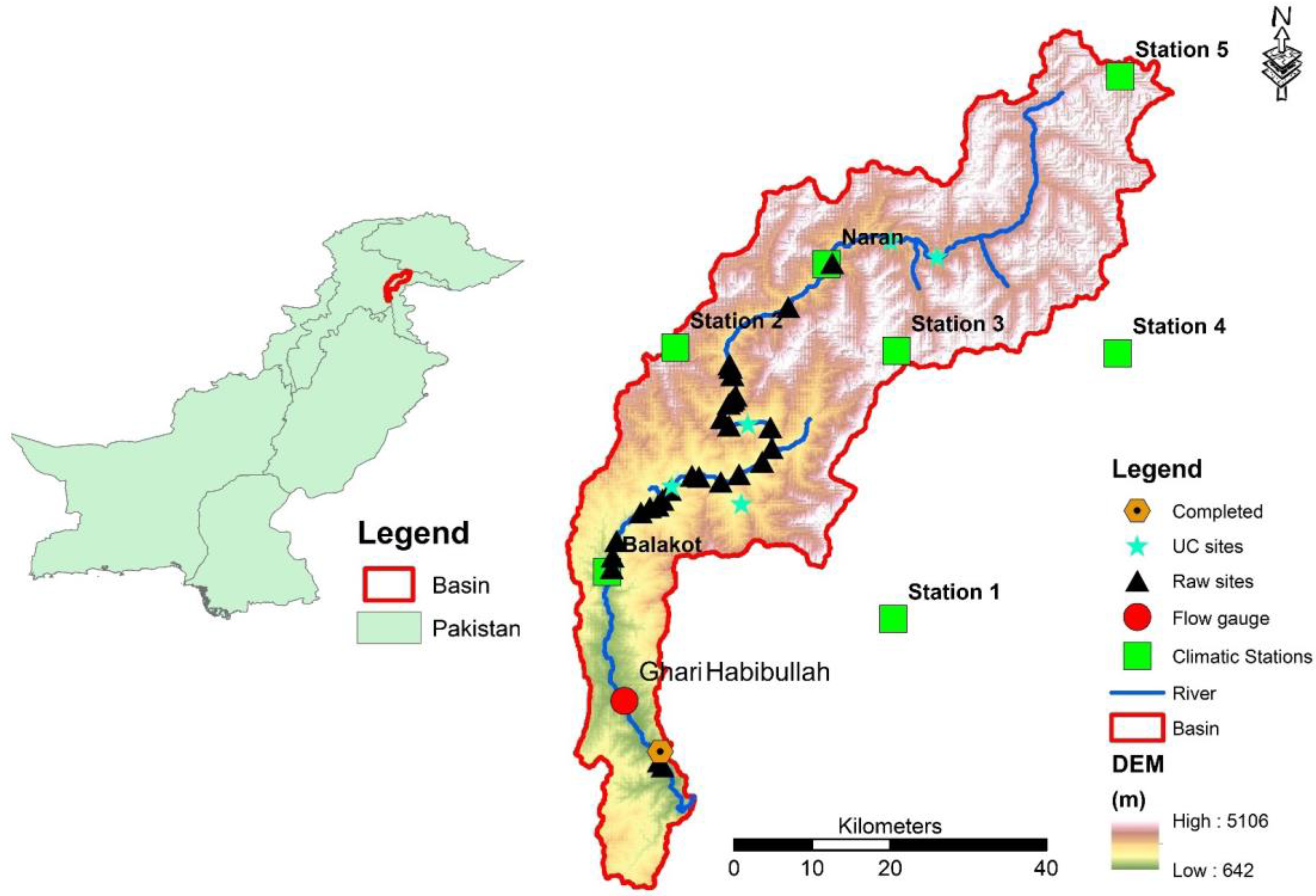
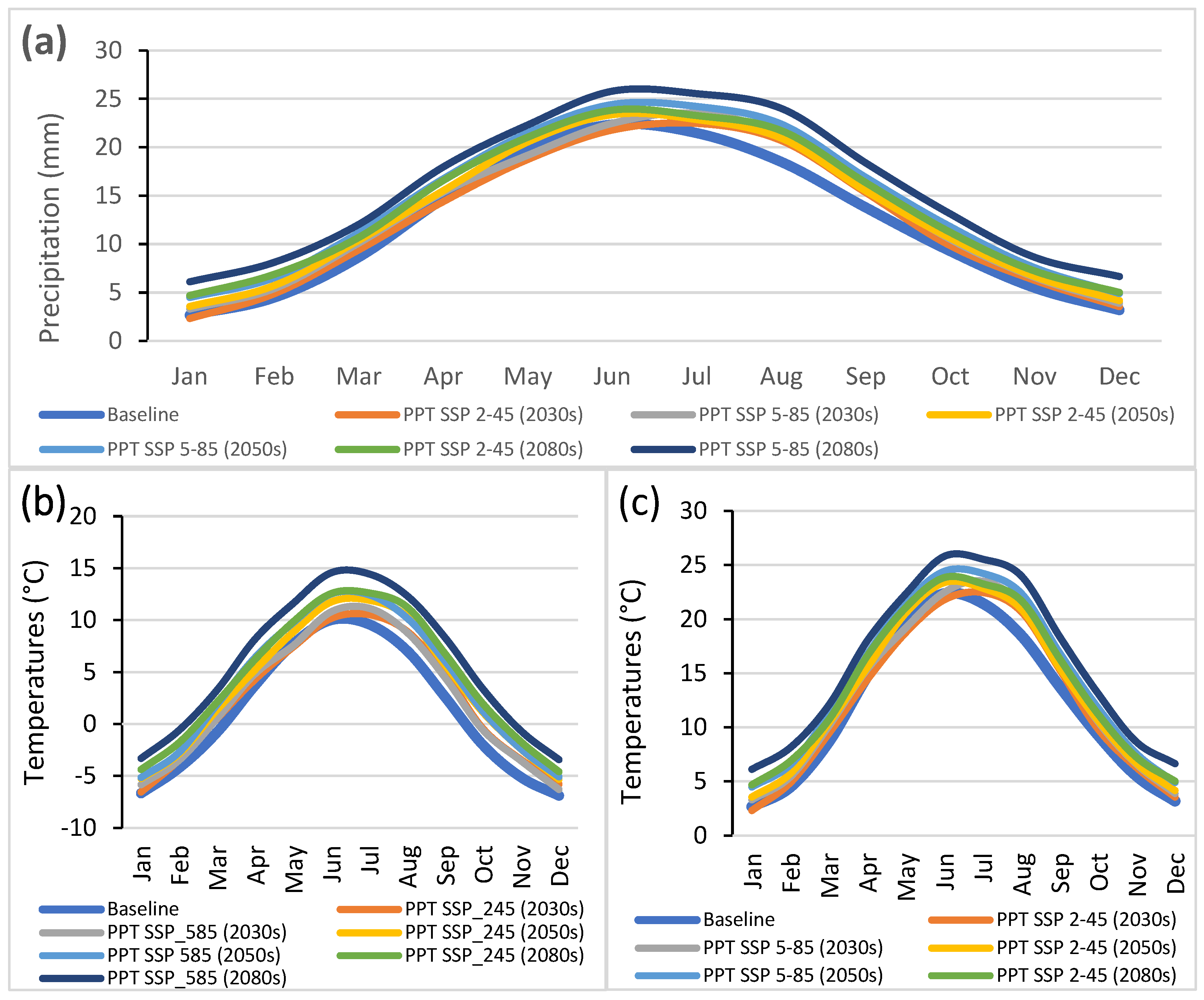
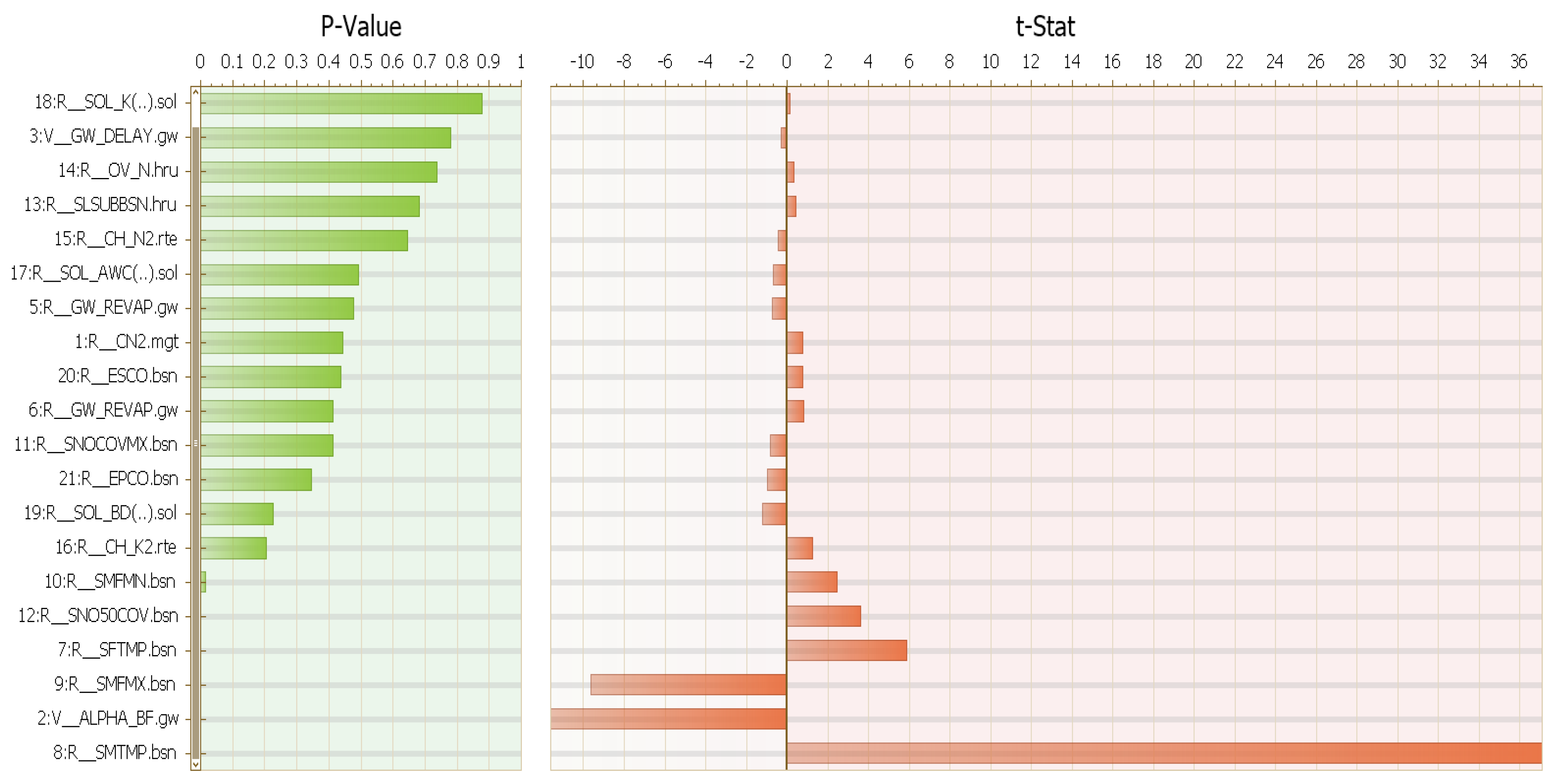
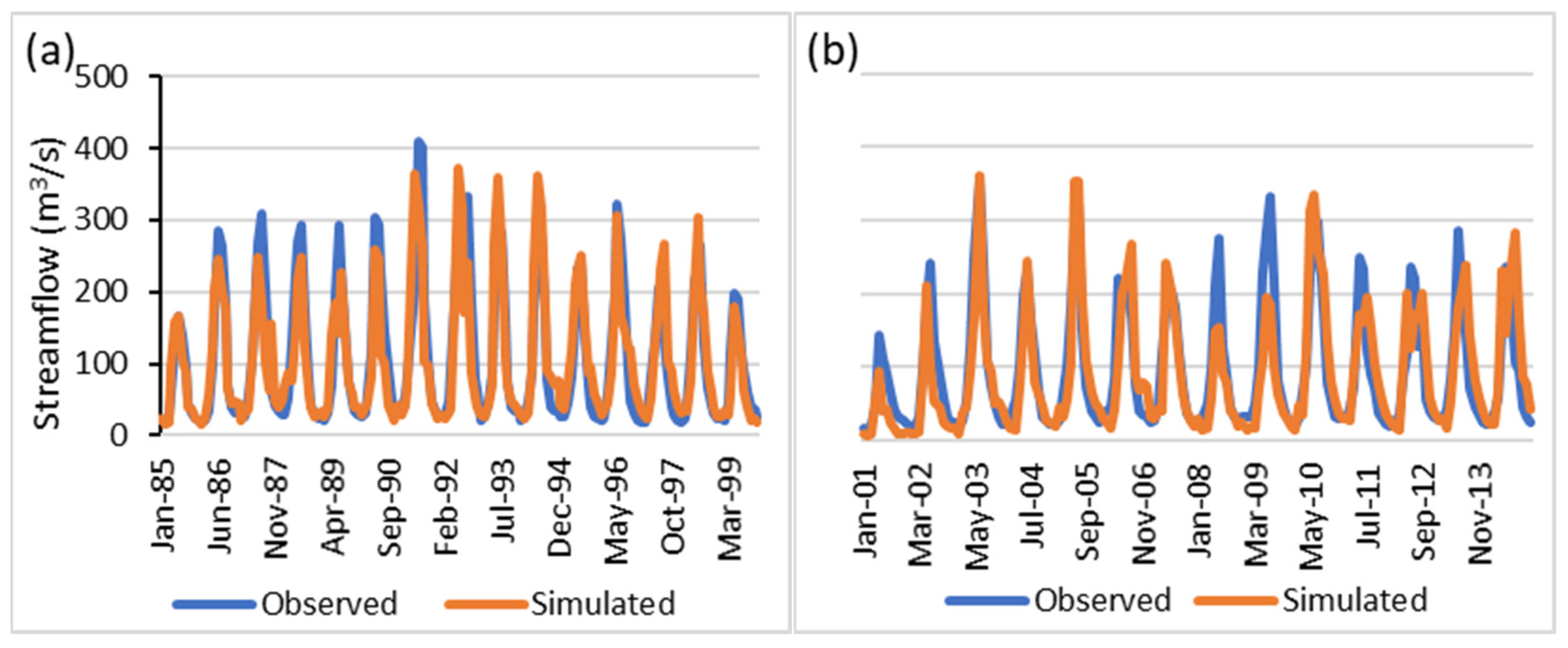
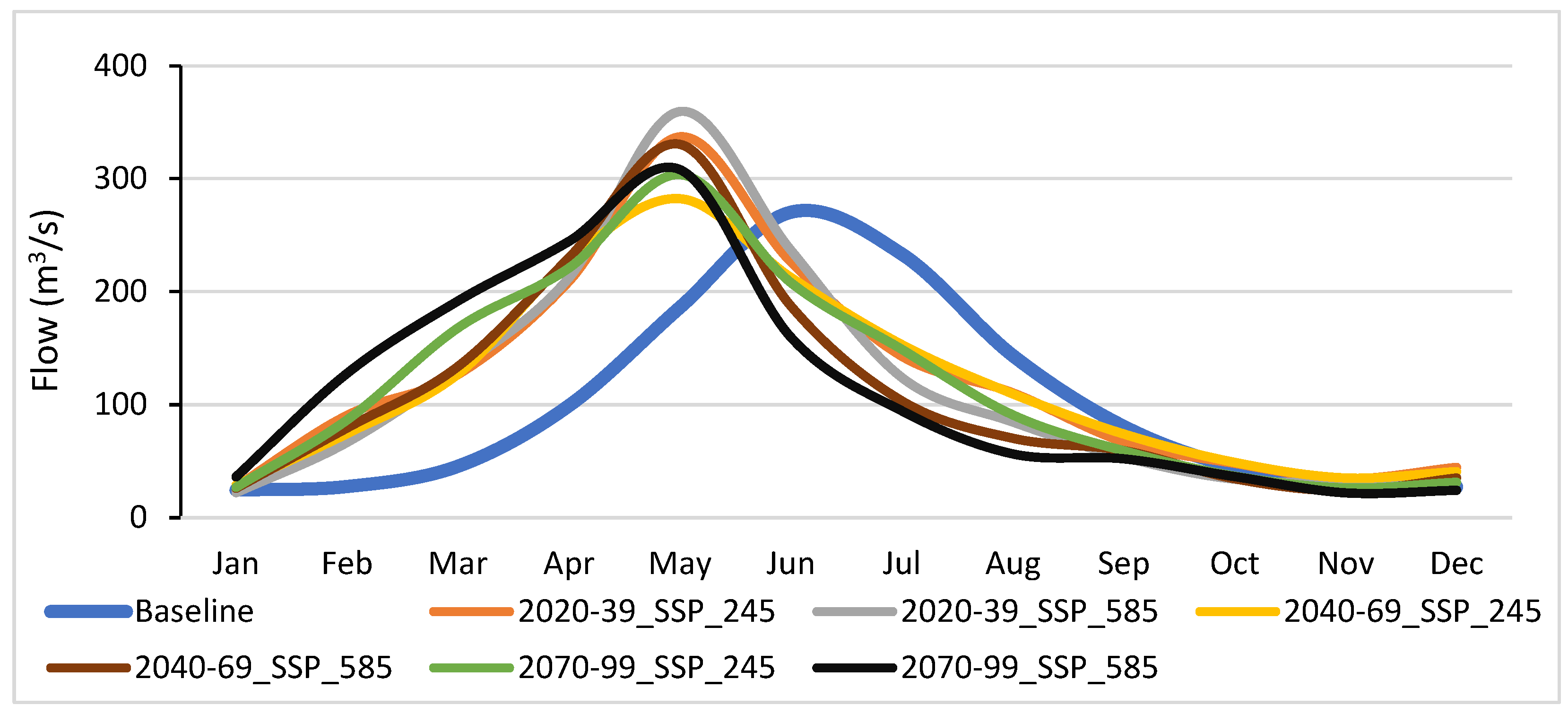
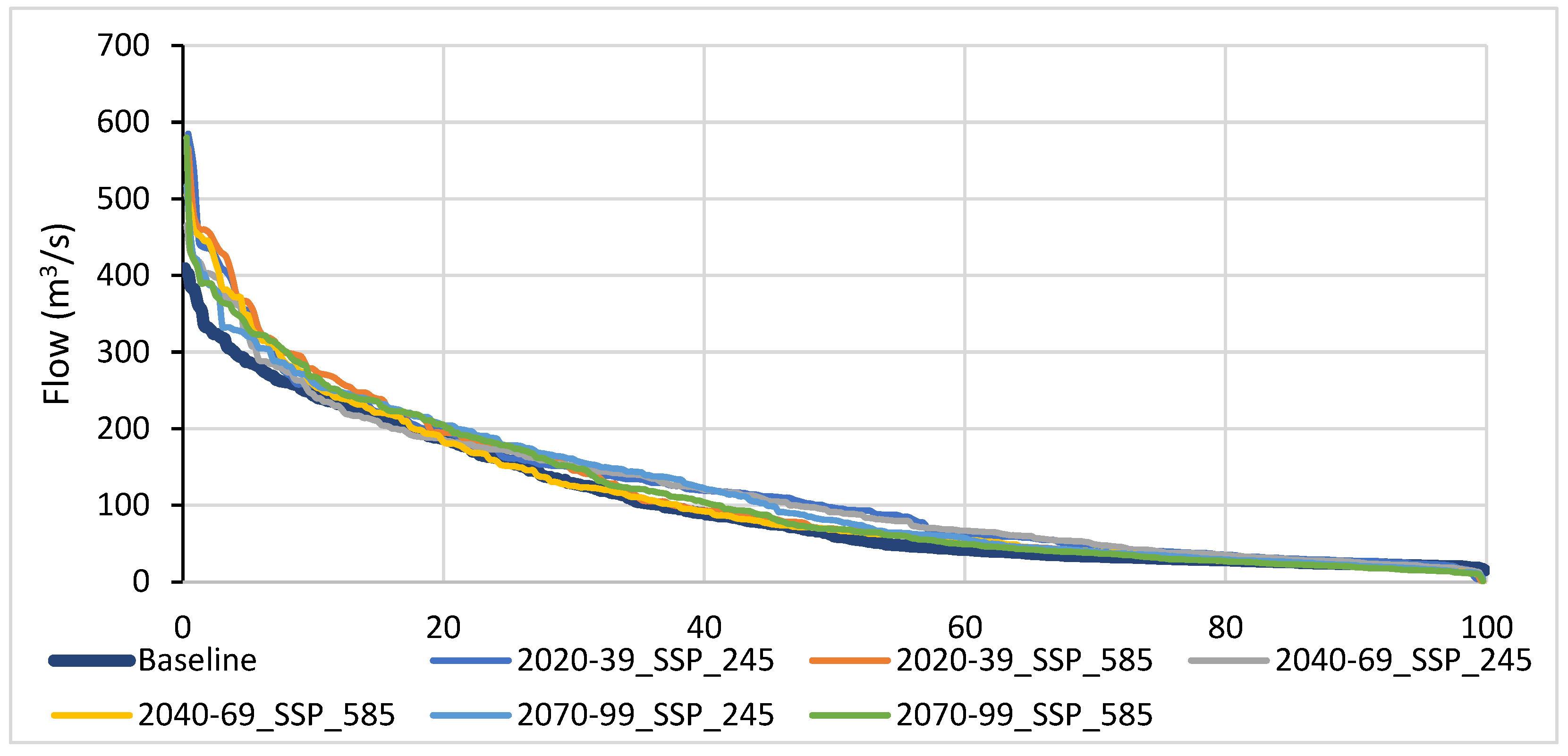
| Data Type | Sourc | Spatial and Temporal Resolution | Time Period | Station | Retrieval Date |
|---|---|---|---|---|---|
| DEM | SRTM | 30 × 30 m | - | - | 20 January 2022 |
| Soil | FAO | 1 × 1 km | - | - | 10 February 2022 |
| Land use | European Space Agency | 300 × 300 m | 2019 | - | 15 February 2022 |
| General circulating models | ECMWF | 250 × 250 km | 1979–2099 | - | 10 December 2022 |
| Streamflow | SWHP | Daily | 1961–2017 | 1 station | 1 April 2022 |
| Temperatures | CFSR | 30 × 30 km and Daily | 1979–2014 | 5 stations | 10 April 2022 |
| SWHP | Daily | 1979–2017 | 2 stations | 10 April 2022 | |
| Precipitation | CFSR | 30 × 30 km and Daily | 1979–2014 | 5 stations | 10 April 2022 |
| SWHP | Daily | 1979–2017 | 2 stations | 10 April 2022 | |
| Relative humidity | CFSR | 30 × 30 km and Daily | 1979–2014 | 5 stations | 10 April 2022 |
| Solar radiation | CFSR | 30 × 30 km and Daily | 1979–2014 | 5 stations | 10 April 2022 |
| Wind speed | CFSR | 30 × 30 km and Daily | 1979–2014 | 5 stations | 10 April 2022 |
| Source | GCMs | Institute | Resolution | Scenario (SSPs) | Duration |
|---|---|---|---|---|---|
| ECMWF | ACCESS-CM-2 | Australian Community Climate and Earth System Simulator Climate Model Version 2 | 250 × 250 km | 2–45 & 5–85 | 2020–2099 |
| CNRM-CM6.1 | Centre National de Recherches Météorologiques Coupled Model version 6.1 | 250 × 250 km | 2–45 & 5–85 | 2020–2099 | |
| MRI-ESM2.0 | The Meteorological Research Institute Earth System Model Version 2.0 | 250 × 250 km | 2–45 & 5–85 | 2020–2099 |
| Site | Lat | Long | Power (MW) | γ * (kN/m3) | Head (m) | Flow (m3/s) | Area (km2) | Status |
|---|---|---|---|---|---|---|---|---|
| 1 | 34.86 | 73.60 | 16.97 | 9.81 | 25 | 69.2 | 1274 | Planned Sites |
| 2 | 34.79 | 73.52 | 30.64 | 9.81 | 41 | 76.2 | 1403 | Planned Sites |
| 3 | 34.79 | 73.52 | 14.24 | 9.81 | 19 | 76.4 | 1407 | Planned Sites |
| 4 | 34.78 | 73.52 | 18.76 | 9.81 | 25 | 76.5 | 1408 | Planned Sites |
| 5 | 34.76 | 73.53 | 36.61 | 9.81 | 48 | 77.7 | 1432 | Planned Sites |
| 6 | 34.75 | 73.52 | 40.53 | 9.81 | 53 | 77.9 | 1435 | Planned Sites |
| 7 | 34.75 | 73.52 | 20.66 | 9.81 | 27 | 78.0 | 1436 | Planned Sites |
| 8 | 34.75 | 73.52 | 14.56 | 9.81 | 19 | 78.1 | 1438 | Planned Sites |
| 9 | 34.73 | 73.51 | 15.80 | 9.81 | 20 | 80.6 | 1483 | Planned Sites |
| 10 | 34.72 | 73.52 | 14.27 | 9.81 | 18 | 80.8 | 1489 | Planned Sites |
| 11 | 34.72 | 73.57 | 14.70 | 9.81 | 18 | 83.3 | 1533 | Planned Sites |
| 12 | 34.70 | 73.58 | 1.74 | 9.81 | 17 | 10.4 | 192 | Planned Sites |
| 13 | 34.68 | 73.56 | 20.39 | 9.81 | 22 | 94.5 | 1740 | Planned Sites |
| 14 | 34.66 | 73.53 | 39.74 | 9.81 | 42 | 96.4 | 1776 | Planned Sites |
| 15 | 34.66 | 73.51 | 40.30 | 9.81 | 40 | 102.7 | 1891 | Planned Sites |
| 16 | 34.66 | 73.48 | 33.92 | 9.81 | 33 | 104.8 | 1930 | Planned Sites |
| 17 | 34.66 | 73.47 | 16.45 | 9.81 | 16 | 104.8 | 1930 | Planned Sites |
| 18 | 34.65 | 73.44 | 18.70 | 9.81 | 18 | 105.9 | 1950 | Planned Sites |
| 19 | 34.63 | 73.43 | 19.75 | 9.81 | 19 | 106.0 | 1952 | Planned Sites |
| 20 | 34.63 | 73.42 | 24.35 | 9.81 | 22 | 112.8 | 2078 | Planned Sites |
| 21 | 34.62 | 73.41 | 20.27 | 9.81 | 18 | 114.8 | 2114 | Planned Sites |
| 22 | 34.62 | 73.40 | 23.75 | 9.81 | 21 | 115.3 | 2123 | Planned Sites |
| 23 | 34.59 | 73.36 | 12.65 | 9.81 | 11 | 117.2 | 2158 | Planned Sites |
| 24 | 34.57 | 73.36 | 14.98 | 9.81 | 13 | 117.4 | 2163 | Planned Sites |
| 25 | 34.55 | 73.36 | 15.38 | 9.81 | 13 | 120.6 | 2221 | Planned Sites |
| 26 | 34.33 | 73.43 | 31.90 | 9.81 | 24 | 135.5 | 2495 | Planned Sites |
| 27 | 34.33 | 73.43 | 23.94 | 9.81 | 18 | 135.6 | 2497 | Planned Sites |
| Balakot HHP | 34.65 | 73.44 | 343.54 | 9.81 | 227.4 | 154.0 | 1952 | Planned Sites |
| Naran HPP | 34.94 | 73.74 | 223.18 | 9.81 | 325 | 70.0 | 905 | Under Construction |
| Batakundi HPP | 34.92 | 73.81 | 111.21 | 9.81 | 218 | 52.0 | 702 | Under Construction |
| Saif Ul Malook | 34.91 | 73.66 | 8.52 | 9.81 | 450 | 1.9 | 57 | Planned Sites |
| Nila da Katha HPP | 34.63 | 73.54 | 14.88 | 9.81 | 394 | 3.9 | 65 | Under Construction |
| Patrind Hydropower Plant | 34.34 | 73.43 | 140.28 | 9.81 | 110 | 130.0 | 1274 | Completed |
| Suki Kinari | 34.72 | 73.54 | 953.34 | 9.81 | 848 | 114.6 | 1403 | Under Construction |
| Sr. # | Parameter | Description | Range | Optimum Value | Unit |
|---|---|---|---|---|---|
| 1 | SFTMP | Snowfall temperature | −5 to 5 | −1.60 | °C |
| 2 | SMTMP | Snow melt base temperature | −5 to 5 | 4.60 | °C |
| 3 | SMFMX | Max snowmelt rate for snow during the year | 0 to 10 | 2.50 | °C |
| 4 | SMFMN | Min snowmelt rate for snow during the year | 0 to 10 | 0.10 | °C |
| 5 | SNOCOVMX | Min snow water content that corresponds to 100% snow cover | 0 to 500 | 20.00 | mm H2O |
| 6 | SNO50COV | Snow cover equivalent that corresponds to 50% snow cover | 0 to 1 | 0.44 | - |
| 7 | ESCO | Soil evaporation compensation factor | 0 to 1 | 0.55 | - |
| 8 | EPCO | Plant uptake consumption factor | 0 to 1 | 1.00 | - |
| 9 | CN2 | Initial SCS runoff curve no. for moisture condition II | 35 to 98 | 78.00 | - |
| 10 | APHA_BF | Base flow alpha factor | 0 to 1 | 0.11 | day |
| 11 | GW_DELAY | Groundwater delay | 0 to 500 | 86.00 | day |
| 12 | GWQMN | Threshold depth of water in shallow aquifer required for the return flow to occur | 0 to 5000 | 900.00 | mm |
| 13 | GW_REVAP | Groundwater “revap” coefficient | 0.02 to 0.2 | 0.075 | - |
| 14 | REVAPMN | Threshold depth of water in the shallow aquifer for “revap” to occur | 0 to 500 | 450.00 | mm |
| 15 | SLSUBBSN | Average slope length | 10 to 150 | 61.38 | m |
| 16 | OV_N | Manning’s “n” value for overland flow | 0.01 to 30 | 0.13 | - |
| 17 | CH_N2 | Manning’s “n” value for the main channel | 0 to 3 | 0.30 | - |
| 18 | CH_K2 | Effective hydraulic conductivity in main channel alluvium | 0 to 500 | 6.10 | mm/h |
| 19 | SOL_AWC | Available water capacity of the soil layer | 0 to 1 | 0.21 | mm H2O/mm soil |
| 20 | SOL_K | Saturated hydraulic conductivity | 0 to 2000 | 14.80 | mm/h |
| Sr. # | Statistical Indicators | Acceptable Ranges | Calibration | Validation |
|---|---|---|---|---|
| 1 | Coefficient of determination (R2) | >0.5 | 0.769 | 0.710 |
| 2 | Nash–Sutcliffe efficiency (NSE) | >0.5 | 0.741 | 0.662 |
| 3 | Percent bias (PBIAS) | −15% < PBIAS < +15% | −3.076 | −6.142 |
| Timestep | Scenarios | Annual | Winter | Spring | Summer | Autumn | Q95 | Q50 | Q5 |
|---|---|---|---|---|---|---|---|---|---|
| Change in Streamflow (%) | |||||||||
| 2030s | 2020–39_SSP_2–45 | 20.1 | 104.9 | 103.3 | −25.8 | −5.7 | 9.7 | 62.8 | 18.2 |
| 2020–39_SSP_5–85 | 14.1 | 57.1 | 112.5 | −31.2 | −24.9 | −15.6 | 16.6 | 25.3 | |
| 2050s | 2040–69_SSP_2–45 | 15.9 | 81.4 | 92.5 | −26.5 | −0.3 | −3.5 | 53.3 | 10.0 |
| 2040–69_SSP_5–85 | 7.6 | 77.4 | 109.7 | −44.2 | −25.9 | −25.0 | 14.8 | 18.5 | |
| 2080s | 2070–99_SSP_2–45 | 15.4 | 82.7 | 109.2 | −30.8 | −22.8 | −22.3 | 35.1 | 11.4 |
| 2070–99_SSP_5–85 | 10.9 | 136.9 | 124.8 | −52.0 | −30.4 | −29.9 | 15.6 | 14.4 | |
| Timestep | Scenario | Q30 (m3/s) | Change in Hydropower Potential (%) |
|---|---|---|---|
| 1961–2017 | Baseline | 128.1 | - |
| 2030s | SSP 2–45 | 146.55 | 14.40 |
| SSP 5–85 | 141.40 | 10.38 | |
| 2050s | SSP 2–45 | 150.55 | 17.53 |
| SSP 5–85 | 124.95 | −2.46 | |
| 2080s | SSP 2–45 | 159.25 | 24.32 |
| SSP 5–85 | 149.00 | 16.32 |
Disclaimer/Publisher’s Note: The statements, opinions and data contained in all publications are solely those of the individual author(s) and contributor(s) and not of MDPI and/or the editor(s). MDPI and/or the editor(s) disclaim responsibility for any injury to people or property resulting from any ideas, methods, instructions or products referred to in the content. |
© 2023 by the authors. Licensee MDPI, Basel, Switzerland. This article is an open access article distributed under the terms and conditions of the Creative Commons Attribution (CC BY) license (https://creativecommons.org/licenses/by/4.0/).
Share and Cite
Akbar, H.; Nilsalab, P.; Silalertruksa, T.; Gheewala, S.H. The Effect of Climate Change on the Hydropower Potential in the Kunhar River Watershed, Pakistan. World 2023, 4, 776-794. https://doi.org/10.3390/world4040049
Akbar H, Nilsalab P, Silalertruksa T, Gheewala SH. The Effect of Climate Change on the Hydropower Potential in the Kunhar River Watershed, Pakistan. World. 2023; 4(4):776-794. https://doi.org/10.3390/world4040049
Chicago/Turabian StyleAkbar, Haseeb, Pariyapat Nilsalab, Thapat Silalertruksa, and Shabbir H. Gheewala. 2023. "The Effect of Climate Change on the Hydropower Potential in the Kunhar River Watershed, Pakistan" World 4, no. 4: 776-794. https://doi.org/10.3390/world4040049
APA StyleAkbar, H., Nilsalab, P., Silalertruksa, T., & Gheewala, S. H. (2023). The Effect of Climate Change on the Hydropower Potential in the Kunhar River Watershed, Pakistan. World, 4(4), 776-794. https://doi.org/10.3390/world4040049






